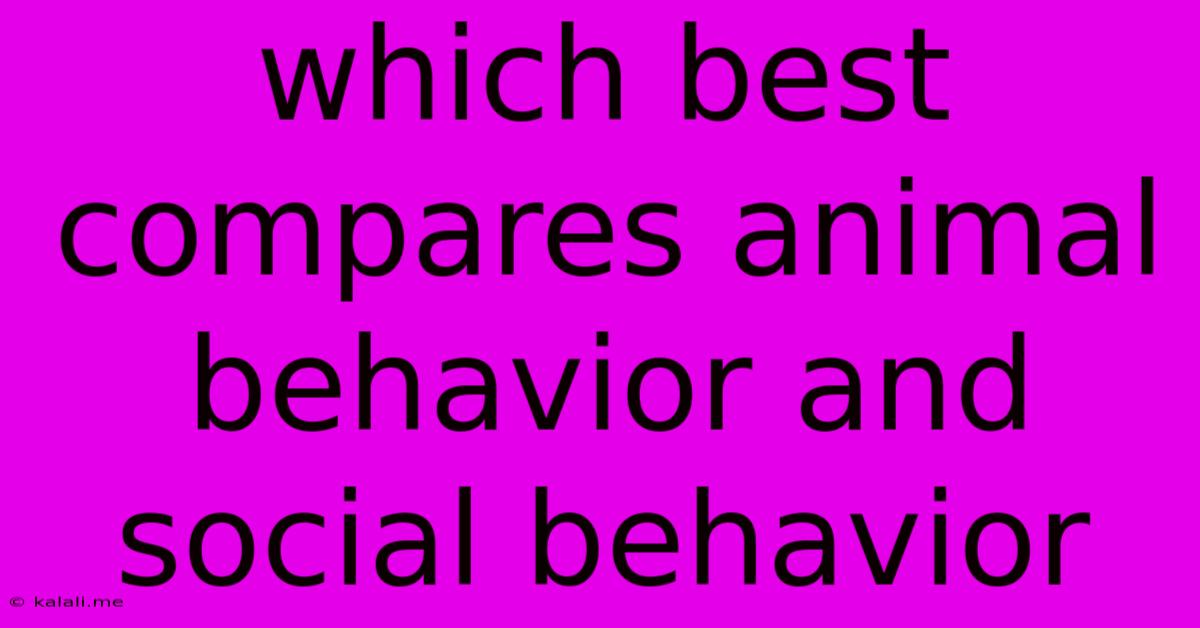Which Best Compares Animal Behavior And Social Behavior
Kalali
May 10, 2025 · 3 min read

Table of Contents
Understanding the Intertwined Worlds of Animal Behavior and Social Behavior
Animal behavior, a vast and fascinating field, encompasses the full spectrum of actions animals perform. This includes everything from simple reflexes like blinking to complex learned behaviors like tool use. However, understanding animal behavior is incomplete without examining its social dimension. Social behavior, a subset of animal behavior, focuses specifically on interactions between individuals of the same species. This article explores the crucial distinctions and overlaps between these two closely related concepts.
What is Animal Behavior?
Animal behavior, also known as ethology, is the scientific study of animal actions and the underlying mechanisms. It considers both the proximate (immediate) and ultimate (evolutionary) causes of behavior. Proximate causes ask how a behavior occurs, focusing on physiological and environmental triggers. For example, a proximate explanation for a bird singing might be the presence of testosterone stimulating its vocal cords. Ultimate causes, on the other hand, ask why a behavior evolved, focusing on its adaptive significance. The ultimate cause of the bird's song could be attracting a mate and ensuring reproductive success.
Several key aspects of animal behavior are analyzed:
- Innate behaviors: These are genetically programmed behaviors, often appearing without prior learning, such as reflexes or instincts. Examples include a newborn baby's sucking reflex or a spider spinning a web.
- Learned behaviors: These behaviors develop through experience and interaction with the environment. Examples include a dog learning to sit on command or a chimpanzee using tools.
- Communication: This encompasses various signals used to interact, including visual, auditory, chemical, and tactile cues. Examples include bee dances, bird songs, and pheromone trails.
- Foraging: This is the process of finding and obtaining food. Foraging strategies vary greatly depending on the species and its environment.
- Reproduction: Reproductive behaviors are essential for species survival and include mate selection, courtship rituals, and parental care.
What is Social Behavior?
Social behavior is the interaction between members of the same species. It's a specialized area within animal behavior that focuses on how animals interact with each other, forming complex social structures and hierarchies. Key aspects include:
- Aggression: Competition for resources, mates, or territory can lead to aggressive behaviors, ranging from displays to physical fights.
- Cooperation: Working together to achieve a common goal, such as hunting or defending territory, improves survival chances.
- Altruism: Behaving in a way that benefits others at a cost to oneself, seemingly contradicting the principle of self-preservation. Examples include alarm calls in meerkats.
- Social hierarchies: Establishment of dominance and submission relationships within a group, often involving rituals and displays. This can influence access to resources and mating opportunities.
- Communication within groups: Complex communication systems often emerge within social groups to coordinate activities and maintain social order.
The Interplay Between Animal Behavior and Social Behavior:
Social behavior is intrinsically linked to animal behavior. Social interactions are simply a specific type of animal behavior, governed by the same proximate and ultimate causes. For example, the aggressive behavior of a male lion defending its pride is a social behavior, but the underlying mechanisms (hormonal influences, neural pathways) are also part of broader animal behavior principles. Similarly, the cooperative hunting strategies of wolves are social behaviors driven by evolutionary pressures (increased hunting success, improved survival).
Many aspects of animal behavior only make sense within a social context. Communication, mating, parental care, and foraging are often significantly influenced by social interactions. Understanding the social dynamics within a group is crucial to understanding individual animal behaviors and their evolutionary significance.
In Conclusion:
While animal behavior is the broader umbrella term encompassing all animal actions, social behavior zooms in on the intricate interactions between individuals. They are inextricably linked, with social behaviors forming a critical component of the overall behavioral repertoire of many species. Studying both aspects provides a deeper and more comprehensive understanding of the complexities of the animal kingdom.
Latest Posts
Latest Posts
-
How Many Cups In A 16 Oz Sour Cream
Jul 02, 2025
-
How Many 1 4 Teaspoons Are In 1 Teaspoon
Jul 02, 2025
-
How Many Tbsp In A Dry Ounce
Jul 02, 2025
-
How Do You Say Grandparents In Spanish
Jul 02, 2025
-
How Many Numbers Are Between 48 To 24
Jul 02, 2025
Related Post
Thank you for visiting our website which covers about Which Best Compares Animal Behavior And Social Behavior . We hope the information provided has been useful to you. Feel free to contact us if you have any questions or need further assistance. See you next time and don't miss to bookmark.